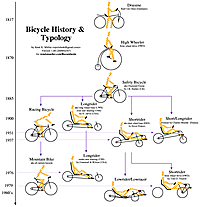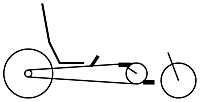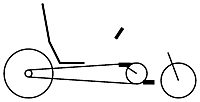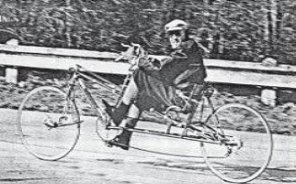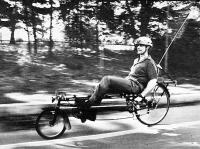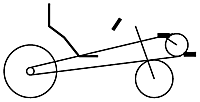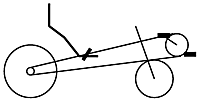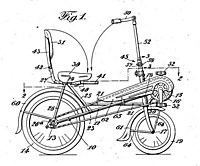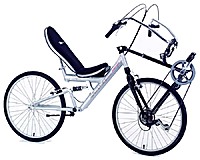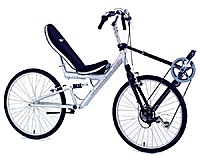UpdatesWed, January 30, 2008: A bit history on recumbents, discussion of diamond frame (DF) vs recumbents, and a small section of bicycle science
.
Mon, January 7, 2008: Included information on hubdynamo
.
Sun, December 2, 2007: Included references of longrider and first version of Avatar 2000 by Dave Wilson
.
Tue, November 27, 2007: Completed overview and more links, and included in this site as well
.
Sat, February 18, 2006: First version, with three main types of recumbents
.
|
re-cum-bent (adjective)
- lying down; reclining; leaning.
- inactive; idle.
- Zoology, Botany. noting a part that leans or reposes upon its surface of origin.
Origin: 1765-75; recumbent- (s. of recumbéns), prp. of recumbere to lie back, equiv. to re- re- + cumb-, akin to cubare to lie down
In order to understand recumbents, I'm giving a brief history of the evolution:
The draisienne was rather a walking bicycle invented by Karl von Drais around 1817, whereas the highweeler around 1870 didn't have a chain but direct drive, and in order to provide decent speed the wheel had to be big and thereby the risk of falling was obvious.
As result of increased risk a "safety" version was developed by J. K. Starley around 1885, which is the raw model of current "ordinary" bicycle. Interestingly for a long time the highwheeler was considered "ordinary" and the "safety" bicycle a special, even "safety" version - this is how history changes.
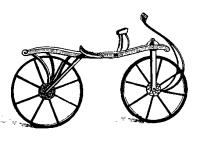
Draisine by Karl von Drais (1817)
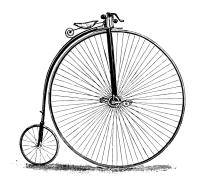
High Wheeler aka Penny Farthing (~1870)
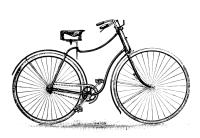
John Kemp Starley's Safety Bicycle (1885)
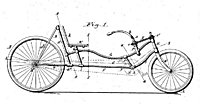
Harold Jarvis longrider, patent excerpt (1901)
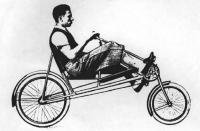
Velocar by Charles Mochet (1931)
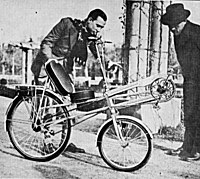
Ravat Shortrider (Vélo Horizontal) (1937)
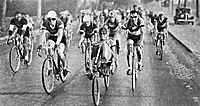
 Manuel Morand with the Velocar at Paris - Vichy (1934) |
Among recumbent enthusiasts the Velocar marks the beginning of the recumbent era, as Manuel Morand participated bicycle races and then Francis Faure 1933 rode a new
speeding record 
of 45.055km in an hour.
In 1934 the world cyclist organization UCI banned the recumbents and kept sticking with the Starley's "safety bicycle" of 1885, and still does.
By this ban the recumbents were out of all "cycling" competition UCI ruled, which made a significant dent in the further development of bicycles itself, and recumbents in particular.
More history at Bicycle History  and The Real History of the Recumbent Bicycle
and The Real History of the Recumbent Bicycle  .
.
Recumbents are bicycles with another frame geometry than the established type (often refered as
Diamond Frame (DF)),
and have shown to suit different features thereby:
- faster due better aerodynamics of the body posture (sitting or almost laying)
- more ergonomic body posture
- more relaxing position good for extensive ridings and tours
- better force application on pedals due comfortable seats
- no wrist-, neck- or backpain anymore, for certain low- and shortriders a head-support is helpful
- more safe to ride, such as the longrider which has a low sitting respectively falling height of 50cm or 20" only, and head-on falling nearly impossible; lowriders might not considered more safe as visibility of those are more limited in daily commuting in traffic
The few main disadvantages most recumbents have are:
- more expensive,
- heavier and
- harder to climb mountains fast as you can't get up and push with your full body weight on the pedals, and also due general heavier frame
One has to learn to climb steady at high pedal frequency, a good gear range is required therefore.
Three main types can be defined as shown below (but there are many more):
The "longrider" named due the long frame, also known as long wheel base (LWB), the pedals are right behind the front wheel.
The steering is relatively steady, independent whether under- or over-seat steering (USS or OSS).
The first longriders came around 1900, as example Harold Jarvis filed patent in 1901, US Patent #690,733.
In 1968 Dan Henry on his own longrider.
The modern type was invented by David Gordon Wilson  , professor at MIT in 1976, who named this type "Avatar 2000", see also his patent
"Recumbent Bicycle" #4,283,070,
applied 1979 and issued 1981.
, professor at MIT in 1976, who named this type "Avatar 2000", see also his patent
"Recumbent Bicycle" #4,283,070,
applied 1979 and issued 1981.
Later inspired collegues formed a company building this type, Fomac Inc., or Dick Ryan made the "Ryan Vanguard  ", other companies adapted the same design such as Radius
", other companies adapted the same design such as Radius  (Germany) and Fateba
(Germany) and Fateba  (Switzerland) often without crediting the original designer, David G. Wilson.
(Switzerland) often without crediting the original designer, David G. Wilson.
I used this recumbent type to make most of my bike rides (see my travel diaries); it's a Fateba L1 (with more photos), 18kg heavy and I bought it used - a few photos:
Longriders are very suitable for long distance travels due the comfortable seat; the wind resistance isn't optimal but still much better than with an ordinary bicycle frame geometry. The longrider popularity has declined the last 10 years due more innovative designs of shortriders and specially the lowriders featured in the next section.
RANS  and Easy Racers
and Easy Racers  seem to offer popular longriders again, which look like very comfortable bicycles,
unfortunately without full suspension which for other recumbents is state-of-the-art.
seem to offer popular longriders again, which look like very comfortable bicycles,
unfortunately without full suspension which for other recumbents is state-of-the-art.
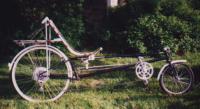
Dave Wilson's Avatar 2000 (~1976)
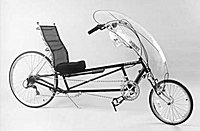
Gold Rush by Easy Racers (USA)

Tour Easy by Easy Racers (USA)

Stratus XP Aluminium by RANS (USA)

Slipstream by Longbikes (USA)
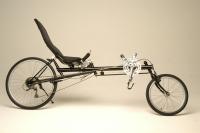
T-Long by Turner Recumbents (USA)
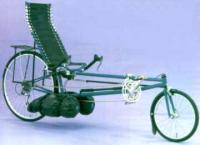
Fateba L1 (Switzerland)
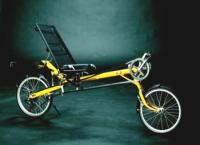
Radius C4 Tour (Germany)
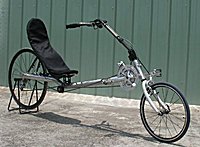
Avenger by TW-Bents (Taiwan)
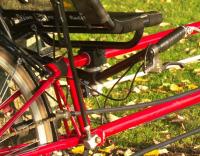
Peer Gynt Detail 1
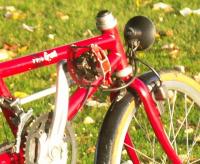
Peer Gynt Detail 2
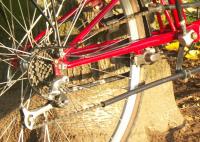
Peer Gynt Detail 3
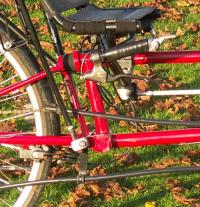
Peer Gynt Detail 4
Photos kindly shared by Robert Crichton.
Comfort:      |
Speed:      |
Commuting:      |
Comfort is excellent, it's very suitable to ride extensively and for long tours, as said, no neck-, back-, or wrist pain anymore.
Speed is better than the "ordinary" bicycle due better aerodynamics.
Commuting is good, a yellow or orange safety flag is highly recommend to be more visible. In general the head position is of height of the car roof, less visible than with "ordinary" bicycle.
- EasyRacers.com
 , USA
, USA
- RANBikes.com
 , USA, aside of longriders also other types such as shortriders
, USA, aside of longriders also other types such as shortriders
- LinearRecumbents.com
 , USA
, USA
- TurnerRecumbents.com
 , USA
, USA
- Radius-Liegeraeder.de
 , Germany, see C4 model
, Germany, see C4 model
- Longbikes.com
 , USA, see for Slipstream model
, USA, see for Slipstream model
- Hasebikes.com
 , Germany, see for Tagun model
, Germany, see for Tagun model
- Fateba.ch
 , Switzerland, no recumbents listed on their web-site yet
, Switzerland, no recumbents listed on their web-site yet
The "shortrider" named due the short distance between the wheels, also known as short wheel base (SWB), usually the pedals are in front of the front wheel.
The steering bar might have different heights, under- or over-seat steering (USS vs OSS), the seat is straight and very comfortable to sit on.
The steering is not very steady due to the shortness of distance between both wheel, and the angle of the steering bar.
One of the first shortriders I found are from
Ravat (1937) a french motorcycle company in St. Etienne, and
Jack Fried (1946) as seen on
US Patent #2,482,472.
The Velocar by Charles Mochet in 1931 is between a longrider and a shortrider - so this may be kept remembered too.

 Front wheel drive (FWD) by Thomas D. Traylor (1979) |
The front wheel drive (FWD) seems first time implemented
by
Thomas D. Traylor 
in 1979, and later in 1982 issued the
Patent #D277,744 which was granted 1985.
Later
FlevoBikeUSA.com 
(no longer in business) and
Cruzbike.com 
followed with commercial variants.
Here a few photos of the Street Machine GT by HPVelotechnik.com  :
:
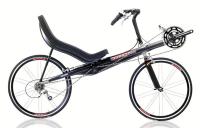
Carbon Aero by Bacchetta (USA)
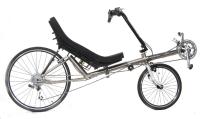
Barcroft Virginia (USA)

Challenge Hurricane Tour (Netherlands)
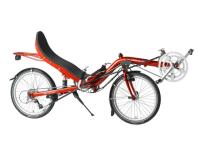
Challenge Hurricane Tour (Netherlands)
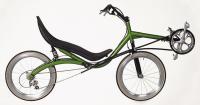
Shock Proof 451 CrMo by M5 (Netherlands)
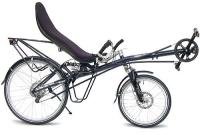
Streetmachine GT by HP Velotechnik (Germany)
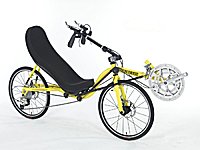
Mustang by TW-Bents (Taiwan)
Comfort:      |
Speed:      |
Commuting:      |
Comfort is good, maybe a bit experience is required to get used to lay almost and new head position, a head support might help to quicker adapt.
Speed is better than with the longrider due better aerodynamics.
Commuting is a bit reduced as you are less visible, a safety flag is highly recommended. Also, for most models you have to get up when you stop in order to reach the ground with the feet, unless you have long enough legs so you can remain recumbent when you stop.
- HPVelotechnik.de
 , Germany
, Germany
- ZOXBikes.com
 , Germany
, Germany
- Challenge-Recumbents.com
 , Netherlands - excellent recumbents, incl. lowriders
, Netherlands - excellent recumbents, incl. lowriders
- BarcroftCycles.com
 , USA
, USA
- BacchettaBikes.com
 , USA
, USA
- M5-Ligfietsen.nl
 , Netherlands
, Netherlands
- CruzBike.com
 , USA & Australia - shortrider (aka moving bottom bracket, MBB) with front wheel drive, conversion kit for mountain bike to recumbent available
, USA & Australia - shortrider (aka moving bottom bracket, MBB) with front wheel drive, conversion kit for mountain bike to recumbent available
- ActionBent.com
 , USA, imports China Mascot bents
, USA, imports China Mascot bents
- TWBents.com
 / China Mascot Products
/ China Mascot Products  , Taiwan, very affordable short-riders
, Taiwan, very affordable short-riders
The "lowrider" due the low seat, and usually the drive is in front of the front wheel. The steering bar is often very narrow, and the chain is very close to the front wheel, so there is a narrow margin for steering curves.
The lowriders are suitable to do speed records as human powered vehicles (HPV),
e.g. 24 hours ca. 1000km, or 1 hour 85km/h, 200m or 1000m with 130km/h,
in such an application a chassis is attached to decrease air resistance even further.
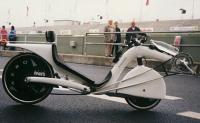
Finest Low Rider: Kreuzotter V5 by Walter Zorn (Germany)
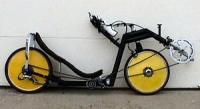
Warren Beauchamp's Barracuda (USA)
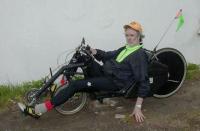
Tom Spollen with Spollen V1 (USA)

Optima Baron (Netherlands)
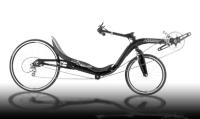
Optima X-Low (Netherlands)
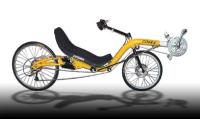
Optima Cobra (Netherlands)
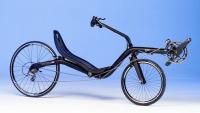
Fujin SL II by Challenge Bikes (Netherlands)

Fujin SL II by Challenge Bikes (Netherlands)
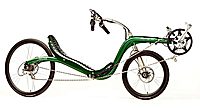
Jester by Challenge Bikes (Netherlands)
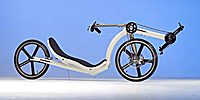
NME Ultra Lowracer by Challenge Bikes (Netherlands)
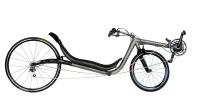
Titanium Low Racer by M5 (Netherlands)

Carbon Low Racer by M5 (Netherlands)

NoCom (No Compromise) by Velokraft (Poland)
Comfort:      |
Speed:      |
Commuting:      |
Comfort looks good, you are laying and your head position might be unusual at first, where a head support might quicken the adapation.
Speed is best, the aerodynamics is excellent and high speeds easy achievable.
Commuting isn't very good I would say, you are hardly visible on the side of a car, and a safety flag is highly recommended and very conscious riding in cities and traffic.
and many others - see below in the "Links" section for buyer's guide for more manufactors of lowriders.
- JetTrike.com
 , various shortrider with tilted wheels and front-wheel drive, with detailed plans
, various shortrider with tilted wheels and front-wheel drive, with detailed plans
- RecycledRecumbent.com
 , long-rider from a normal bike
, long-rider from a normal bike
- Zephyr.nl
 , frame-kit
, frame-kit
- DutchBikes.nl
 , does not sell frame kits anymore, but KS2 2.9 Manual
, does not sell frame kits anymore, but KS2 2.9 Manual  (PDF) still available
(PDF) still available
- MARS (Metro Area Recumbent Society)
 , great people sharing their enthusiasm, incl. plans
, great people sharing their enthusiasm, incl. plans
- WISIL (Wisconscon-Illinois Human Powered Vehicle group)
 , another excellent site
, another excellent site
- T.D. Traylor Front Wheel Drive
 , sells plans
, sells plans
- ManyTracks.com: Self-Built Recumbents Gallery
 , lot of examples with links
, lot of examples with links
- Jim Scozzafava's Recumbent Passion
 , detailed photos of custom built carbon fiber frames
, detailed photos of custom built carbon fiber frames
Next Page >>
Content:


 of 45.055km in an hour.
of 45.055km in an hour.
 in 1979, and later in 1982 issued the
Patent #D277,744 which was granted 1985.
Later FlevoBikeUSA.com
in 1979, and later in 1982 issued the
Patent #D277,744 which was granted 1985.
Later FlevoBikeUSA.com  (no longer in business) and Cruzbike.com
(no longer in business) and Cruzbike.com  followed with commercial variants.
followed with commercial variants.







